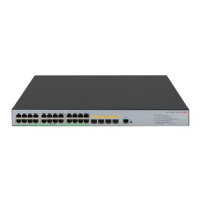79
• Static multicast routing table—Contains the RPF routing information defined by the user through
static configuration.
MBGP multicast routing table and static multicast routing table are used for RPF check rather than
multicast routing.
When a router performs an RPF check, it searches its unicast routing table, MBGP routing table, and
static multicast routing table at the same time. The specific process is as follows:
1. The router chooses an optimal route from the unicast routing table, the MBGP routing table, and
the static multicast routing table:
{ The router automatically chooses an optimal unicast route by searching its unicast routing table,
and using the IP address of the packet source as the destination address. The outgoing
interface in the corresponding routing entry is the RPF interface and the next hop is the RPF
neighbor. The router considers the path along which the packet from the RPF neighbor arrived
on the RPF interface to be the shortest path that leads back to the source.
{ The router automatically chooses an optimal MBGP route by searching its MBGP routing table,
and using the IP address of the packet source as the destination address. The outgoing
interface in the corresponding routing entry is the RPF interface and the next hop is the RPF
neighbor.
{ The router automatically chooses an optimal static multicast route by searching its static
multicast routing table, and using the IP address of the packet source as the destination address.
The corresponding routing entry explicitly defines the RPF interface and the RPF neighbor.
2. The router selects one of these optimal routes as the RPF route. The selection process is as follows:
{ If configured to use the longest match principle, the router selects the longest match route from
these optimal routes. If the three routes have the same mask, the router selects the route with the
highest priority. If the three routes have the same priority, the router selects a route as the RPF
route according to the sequence of static multicast route, MBGP route, and unicast route.
{ If not configured to use the longest match principle, the router selects the route with the highest
priority. If the three routes have the same priority, the router selects a route as the RPF route
according to the sequence of static multicast route, MBGP route, and unicast route.
RPF check process
The basis for an RPF check is as follows:
• Unicast routing table—Contains the shortest path to each destination subnet.
• Static multicast routing table—Contains the RPF routing information defined by the user through
static configuration.
When a router performs an RPF check, it searches its unicast routing table, and static multicast routing
table at the same time. The specific process is as follows:
1. The router chooses an optimal route from the unicast routing table, and static multicast routing
table:
{ The router automatically chooses an optimal unicast route by searching its unicast routing table,
and using the IP address of the packet source as the destination address. The outgoing

